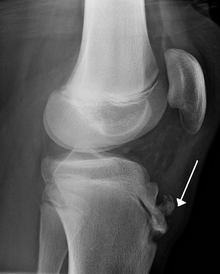Exercise as it relates to Disease/Osgood-Schlatter Disease and Exercise

Overview
[edit | edit source]Osgood-Schlatter disease (OSD) is a disease occurring in preadolescent children whereby damage is suffered to the tibial tuberosity due to repeated stress from muscle contraction eventually resulting in an apophyseal avulsion. Usually presenting in preadolescent athletes, performing running and jumping activities, due to overdeveloped strength of the quadriceps muscle group and the still developing and subsequently weak tibial apophysis.[1]
Clinical Presentation
[edit | edit source]OSD appears between the ages of 8 and 14 years in girls and 10 to 15 years in boys, especially in children who actively participate in sporting activities. The individual often presents with a vague history of previous symptoms and present with acute symptoms of;
- tenderness and swelling over tibial tuberosity,
- pain and resulting limitation in range of motion, particularly with knee extension, though also with flexion.
- Bilateral presentation may occur.
X-ray investigation can determine the presence of apophyseal avulsion.[2](see image)
Sonography can determine soft tissue complications of;
- pretibial swelling,
- fragmentation of the ossification center,
- thickening of the patellar tendon insertion,
- excessive fluid in the infrapatellar bursa.
Treatment
[edit | edit source]Generally, conservative treatment is recommended with uncommon cases of surgical intervention. The client is recommended to cease exercise that puts strain on the injury i.e. running and jumping or heavy lifting (repeated explosive or prolonged heavy contraction of the quadriceps muscle group).
It was found that mean knee extension/flexion ratio in OSD subjects as compared to non-OSD subjects were 73/30 ft.lbs=2.4 to 78/42 ft.lbs.=1.85 respectively. Suggesting that correcting the flexibility and strength imbalance between the quadriceps and hamstrings muscles, associated with OSD, may assist to reduce the chance of re-occurrence.[4]
Outcomes
[edit | edit source]The prognosis of OSD is usually self-limiting, with spontaneous recovery reported in 1–2 years regardless of treatment. Acute symptoms of the condition resolve at 6–8 weeks.[1]
Long-term outcome is good for the majority of individuals though some complications namely;
- pseudarthrosis,
- genu recurvatum,
- patella alta,
- fragmentation or migration of the ossicle may occur.
It has been suggested that these may lead to some disability persisting into late adolescence and even adulthood with potentially the development early osteoarthritis in the chronic stage (most common in conjunction with patella alta). A residual bony prominence at the tuberosity or a small ossicle that may develop in the patellar tendon impinging the tendon resulting in pain and discomfort that, if chronic, may necessitate surgical intervention.[5]
References
[edit | edit source]- ↑ a b Antich, T.J. & Brewster, C.E. 1985, "Osgood-schlatter disease: review of literature and physical therapy management", The Journal of orthopaedic and sports physical therapy, vol. 7, no. 1, pp. 5.
- ↑ Kaya, D.O., Toprak, U., Baltaci, G., Yosmaoglu, B. & Ozer, H. 2013, "Long-term functional and sonographic outcomes in Osgood–Schlatter disease", Knee Surgery, Sports Traumatology, Arthroscopy, vol. 21, no. 5, pp. 1131-1139.
- ↑ Blankstein, A., Cohen, I., Heim, M., Salai, M., Chechick, A., Ganel, A. & Diamant, L. 2001, "Ultrasonography as a diagnostic modality in Osgood-Schlatter disease", Archives of orthopaedic and trauma surgery, vol. 121, no. 9, pp. 536-539.
- ↑ Browner-Elhanan, K.J., Small, E., Coupey, S. & Lee, R. 1999, "LOWER LIMB FLEXIBILITY AND MUSCLE STRENGTH IN OSGOOD SCHLATTER DISEASE", Medicine & Science in Sports & Exercise, vol. 31, no. Supplement, pp. S359.
- ↑ Çakmak, S., Tekin, L. & Akarsu, S. 2014, "Long-term outcome of Osgood-Schlatter disease: not always favorable", Rheumatology international, vol. 34, no. 1, pp. 135-136.
